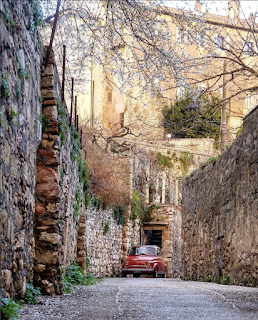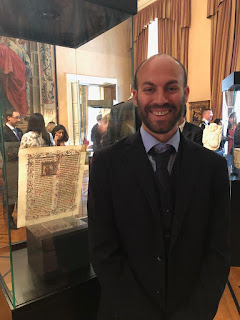 Antiquities; Looting; Italy,ARCA,art crime,cultural heritage,Edgar Tijhuis,stefano allesandrini
Antiquities; Looting; Italy,ARCA,art crime,cultural heritage,Edgar Tijhuis,stefano allesandrini
 No comments
No comments
Interview with Stefano Alessandrini, Forensic Antiquities Analyst and ARCA Professor
By Edgar Tijhuis*
As part of ARCA’s ongoing effort to give prospective participants a deeper look behind the scenes of our Postgraduate Certificate Programmes in Art Crime and Cultural Heritage Protection, Edgar Tijhuis speaks with our faculty members about their work, their motivations, and the unique learning environment we create each summer in Italy.
This series aims to offer future participants a personal glimpse into the people who teach with ARCA, the community around it, and what to expect in the coming year.
To begin, could you tell us a bit about yourself?
My love for archaeology and the history of ancient art began a very long time ago. And I think it was a sign of destiny. You have to consider that I was born in Fano, the city where the bronze statue of the victorious athlete — looted and now at the Getty Museum — was found by our local fishermen. As a child I played with Roman amphorae found in the sea, some of which decorated the gardens belonging to friends of my father. When my family moved to Rome, I joined the youth group of the Gruppo Archeologico Romano, and one of our missions was the excavation and recovery of the necropolis of Cerveteri.
In Cerveteri I had my first encounter with the terrible phenomenon of clandestine excavations, and I decided that my future would be to fight to defend Italy’s cultural heritage. I remember that we would go into the tombs and steal the tomb robbers’ excavation tools! I continued like this throughout my life, defending my country, and I have had the honour of collaborating with the Ministry of Culture on many occasions.
Many years ago I met Noah Charney, who suggested that I join ARCA and organise specific visits to Cerveteri to teach about the trafficking of archaeological artefacts from the Banditaccia World Heritage Site. From that moment on, I combined my passion with that of ARCA's and now, together with Lynda Albertson (ARCA’s CEO), I also lead a course on open source intelligence, as well as serving as the docent to Cerveteri during ARCA's art law course. It is an extraordinary experience, because we can exchange knowledge at an international level with leading experts in this field.
How have you been involved in other excavations?
Through these I am very happy to have enabled participants in the ARCA course to see firsthand how an Italian archaeological excavation takes place (and some students later returned volunteering to excavate themselves). I think this is a great experience to share, to understand even more clearly the collective importance of defending our cultural heritage.
From your perspective, what makes ARCA’s Postgraduate Certificate Programme truly unique and valuable?
Amelia, moreover, is an exceptional town with 2,500 years of history, which helps you understand how much our soul needs contact with such an important past: we are what our ancestors have left us as an inheritance.
How does the location in Italy — surrounded by centuries of cultural heritage — enhance the learning experience for participants?
The incredible history of Italy offers a one-of-a-kind life experience. Students who come from countries with different cultures will find in Amelia (and in all the nearby regions) exceptionally open with important testimonies of our past: Roman and medieval towns, castles, churches, museums, beautiful natural places, and much more.
Are there particular site visits that you find especially valuable?
I consider the visit—together with my lecture—in Cerveteri very important, because it is an extraordinary symbolic place for understanding the very serious problem of archaeological plunder and what fuels clandestine excavations. But it is also a place of rebirth and recovery: in fact, I take students to see the excavations carried out by our group and some works of ancient art that Italy has finally recovered from American museums. First among them is the fantastic Euphronios Vase, which is now the star of the museum in Cerveteri.
Moreover, we at ARCA are the only ones who can enable, in collaboration with the GATC, our students to take part in one or more days on an archaeological excavation such as that of the Roman town of Castrum Novum (a fascinating experience, which offers a great opportunity for cultural exchange among people of various nationalities).
As we look toward the 2026 programmes, which developments or emerging issues in the field of art crime do you consider particularly important, and how will these be reflected in your course?
We must teach people to be attentive in the art market and to identify suspicious signals about the provenance of works offered for sale by dealers and auction houses. ARCA is one of the best organisations in the world in this field for identifying problematic transactions and problematic art market professionals. Those who come to take our courses will have a lively and exciting experience of investigation and study.
What key skills, perspectives, or tools do you hope participants will gain from your course? In what ways can they apply these insights in their professional or academic paths?
First and foremost, I would like my course to convey my passion and love for the cultural heritage of our past and to teach how everyone can contribute to its defense, which is so important worldwide. Our course provides an excellent foundation for exploring the often problematic world of ancient and modern art and the relevant legal frameworks.
One of the most interesting components is helping our students develop open-source intelligence (OSINT) skills, essential for anyone seeking to study or investigate art crime because so much evidence of illicit activity now exists in publicly accessible digital spaces. Trafficked artworks often surface in online auctions, social media posts, dealer catalogues, museum databases, and archival sources scattered across jurisdictions but learning how to tie them together is a skill.
By honing these methods researchers can begin to trace the movement of cultural objects, identify networks of traffickers, verify provenance claims, and detect inconsistencies that may signal criminal activity, all of which can certainly help to find work and experience in the museum sector and in public, private, or foundation collections, or in the field of antiques and auctions.
If someone is considering applying to ARCA’s 2026 programmes, what advice would you give them? And why do you think now is a meaningful moment to engage with this field?
Put all your passion into it and never stop in your search for knowledge: study books, but above all observe and experience every aspect of cultural heritage, and engage with the art trade through visits to archaeological and historical sites, exhibitions, and auctions.
We are certainly living through a very important period for the recovery and return of looted works of art. In many countries, an awareness is developing of the need to safeguard their own history. Cultural heritage, moreover, is always in danger because of wars and sensational thefts. These are battles that ARCA specialists fight every day at an international level. Our students will thus be able to gain experience and develop their own areas of expertise in their own part of the world or in their own discipline. Lastly, having met so many wonderful people, I never would have met had they not connected with ARCA, I can say that their life will be changed and they will experience fantastic cultural adventures which will enrich their life and their soul.
About Stefano Alessandrini
Dr Stefano Alessandrini is an Italian cultural heritage protection specialist with 30 years of object-based archival and forensic provenance research experience. He is a Subject Matter Expert for the Italian Ministry of Culture and an expert in archaeology and ancient art for the Court of Rome, supporting the court's legal trafficking dossiers and restitution cases.
Since 2010, he has lectured and conducted forensic research related to art and antiquities crime within ARCA, focusing on transnational crime mapping and cross-border intelligence. He holds advanced qualifications in cultural heritage protection (Roma Tre / MiBACT / Carabinieri TPC) and a degree in Art Heritage History and Conservation, graduating cum laude. His work bridges Italian cultural property law, cultural diplomacy, and practical restitution and repatriation efforts, and he has published on art crime and recovery strategies
* Dr Edgar Tijhuis
is Academic Director at ARCA and is responsible for coordinating ARCA’s
postgraduate certificate programmes. Since 2009, he has also taught criminology
theory modules within ARCA's PG Certification programming.
























